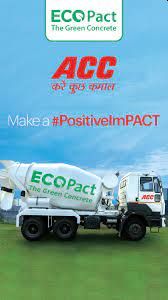https://www.freepressjournal.in/business/sustainability-makes-economic-sense-says-accs-ceo-sridhar-balakrishnan
ACC works relentlessly towards sustainability

The sustainability focus for ACC, a subsidiary of Holcim, is on account of two key concerns. The first is that every citizen of this world should leave it a better place for our children than what it was when we lived in it. The second is that good energy and environmental practices can be excellent for the bottom line as well.
Sridhar Balakrishnan, Managing Director and Chief Executive Officer of ACC, talks about the focus of the company and the decision to place sustainability as the key focus area. He shares the company’s activities with FPJ’s Jescilia Karayamparambil and R N Bhaskar.
Tell us about ACC’s sustainability agenda:
ACC is one of the early companies to have taken the net-zero pledge by 2050. We are deeply committed to the sustainability agenda. We have a clear milestone-driven roadmap until 2030.
This has been endorsed by the Science Based Targets initiative (SBTi).
ACC’s agenda is an integral part of the vision statement in terms of communication and cultural standpoint. We need to do business sustainably. So, that we can leave the earth in a much better place than before.
The four pillars we have divided the sustainability journey into are climate and energy; circular economy; environment; people and community.
We evaluated every element in our value chain. So, that we can ensure that we work on each one of them. This will enable us to improve our sustainability performance.
For instance, we are leveraging technology through our transport analytics centre which helps cut lead time in delivery. This means trucks spend less time on the road.
Are there any new products in the pipeline?
We are deeply committed to driving products that are sustainable in nature. We are driving a high volume of blended cement. This means less clinker per tonne of cement is consumed. This leads to a drastic drop in carbon dioxide emissions.
We are looking at launching more products that are greener in nature. For instance, in our concrete business, we have launched a product called Ecopact. This product is greener compared to existing products in the market. It has been very well received in the market as well.
Today, the marketing and sales team have a Key Performance Indicator (KPI) for blended cement. There are specified targets for ensuring sustainability. These are fairly aggressive targets and are monitored on a daily basis. It has now become part of our day-to-day operations.
Have you planned any new investments?
We are investing in technology. So, that our plants become a lot more efficient. This efficiency helps us to reduce power consumption while manufacturing various products.
ACC and Ambuja (both are part of the same group) are investing heavily in clean, green power. There is a significant investment outlay for waste heat recovery (WHR) in every plant. (With this, the plants capture and reuse existing heat to generate electricity and reduce fossil fuel consumption.)
We are also increasingly looking at increasing the percentage of solar and wind in our overall power mix.
From the value-chain standpoint, we are driving the sustainability agenda. It is not just part of our vision but part of our strategy. Even the KPIs across functions and levels have been factored in.
It is not like a one-off business that we want to engage in.
Even if you look at the capital allocation, it has gone up in the last few quarters – whether it is technology, logistics, plants etc.
We are doing away with coal-based power plants in all our new projects that are coming up.
Thus, sustainability is not an isolated idea, but an integral part of how we intend to do good.
We have made strides but there is still a long way to go to drive our sustainability agenda. We do devote a large amount of time to the sustainability agenda.
A lot of your work includes creating awareness about your work. Tell us about that.
It is an ongoing process. In the case of Ecopact, we have seen the ecosystem has been warming up to such a product.
Sustainability and growth: How do they go hand in hand?
As far as sustainability and commercial interest is concerned, they go hand in hand. There is no dilemma. Even if there is a dilemma, in today’s world sustainability talks. Any plan that does not meet the sustainability criteria will not pass the muster.
Going forward, if there is a trade-off between commercial benefits and sustainability, the latter triumphs.
What kind of challenges do you think will impact the sustainability agenda?
There has been a rise in people migrating from rural to urban India. This will continue for some more years. This will see a rise in people moving from kaccha (mud-walled houses found in villages) to pakka (cement and concrete) houses. The government is also giving a push to infrastructure. So, the consumption of cement will go up phenomenally.
We have created a prototype for sustainable housing. The question is how do you push sustainable houses among customers.
The second challenge is to create cementation material that generates low carbon.
The third challenge is to change the attitude of people towards sustainability. While the journey is on, it is still in its infancy. There is a lot more that needs to be done and can be done.
The last challenge is how do you communicate to people about a product.










































COMMENTS